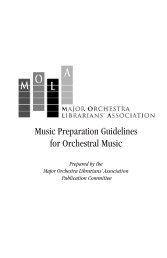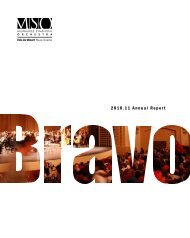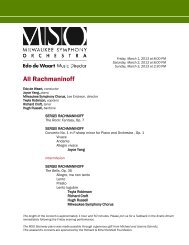contemplation - Milwaukee Symphony Orchestra
contemplation - Milwaukee Symphony Orchestra
contemplation - Milwaukee Symphony Orchestra
Create successful ePaper yourself
Turn your PDF publications into a flip-book with our unique Google optimized e-Paper software.
Conductor’s Insight<br />
Conductor’s Insight<br />
Charles Ives 1874 –1954<br />
in ives’s words:<br />
“… as the time goes<br />
on, and after a “secret<br />
conference”, [the<br />
sections] seem to realize<br />
a futility, and begin to<br />
mock “The Question”<br />
— the strife is over for<br />
the moment.”<br />
…<br />
Ives: The Unanswered Question<br />
Subsequently, Romantic era composers would make grand philosophical works like the<br />
Seven Last Words commonplace (think Richard Strauss’ tone poem Also Sprach Zarathustra<br />
or Mahler’s Resurrection <strong>Symphony</strong>). Just a little after that came one of the most effective<br />
works in this genre, The Unanswered Question by Charles Ives. This brief, but evocative piece<br />
was written in 1906 as part of a pair of works titled “Two Contemplations”. There are three<br />
independent sections within the ensemble: strings sustaining ethereal chords, a calmly<br />
melodic solo trumpet and four wind players to contrast the trumpet. Once again, I will let Ives<br />
speak for himself:<br />
The strings are to represent “the Silences of the Druids — Who Know,<br />
See and Hear Nothing.” The trumpet intones “The Perennial Question of<br />
Existence”, and states it in the same tone of voice each time. But the hunt<br />
for “The Invisible Answer” undertaken by the winds, becomes gradually<br />
more active, fast and louder. “The Fighting Answerers”, as the time goes on,<br />
and after a “secret conference”, seem to realize a futility, and begin to mock<br />
“The Question” — the strife is over for the moment. After they disappear,<br />
“The Question” is asked for the last time, and “The Silences” are heard<br />
beyond in “Undisturbed Solitude.”<br />
The piece is vague enough to have puzzled, fascinated and haunted both musicians<br />
and audiences alike for the past century. It even became the title of a series of famous<br />
lectures given by Leonard Bernstein at Harvard on the universality of music.<br />
Leonard Bernstein at Harvard<br />
8<br />
Wagner: Prelude and “Liebestod” from Tristan und Isolde<br />
Richard Wagner<br />
1813 – 1883<br />
In stark contrast to Ives’ compact look at the question of existence,<br />
Wagner’s opera, Tristan and Isolde, is a four-hour long epic on<br />
the same question (and one could argue that it does no better<br />
at resolving it!). Unfortunately, it is easy to get stuck on the<br />
surface of the storyline with magic potions and love affairs.<br />
However, the plot begins to make more sense when we look<br />
at it through the philosophical lens of Arthur Schopenhauer.<br />
Wagner was immediately taken by Schopenhauer’s idea of<br />
two worlds with which we struggle — one in which we are<br />
consumed by desires and dreams and the other where we<br />
fail against the unknowable reality. So when Tristan and Isolde<br />
seem to be pathetically lamenting their impossible love for hours<br />
on end, it is actually a vehicle for discussion about the two worlds<br />
of human desire and reality.<br />
We finish our concert with the Prelude and “Love-Death” from Tristan<br />
and Isolde — the beginning and the end of the opera. The Prelude<br />
beautifully sets up this opera, giving us the famous “musical question” in the opening cello line and<br />
wind chords. The music then seems to contemplate the question of existence along with us, nearly<br />
finding answers, but<br />
always falling back into<br />
darkness. Suddenly,<br />
the music takes on an<br />
assertive quality when<br />
we reach the “Love-<br />
Death.” It starts with a<br />
far away breath, but<br />
then steadily builds<br />
in intensity. In an<br />
ecstatic trance, Isolde<br />
decides that she would<br />
rather die than give<br />
into the cold reality<br />
of life without Tristan.<br />
Interestingly enough,<br />
Wagner would return<br />
to this same question in Parsifal, but this time the hero chooses to overcome his desires in order to<br />
face reality. So in the end, like any good evening filled with philosophical undertakings, we leave<br />
with more questions than when we started — perhaps only learning that magic potions are best<br />
left untouched.<br />
9








